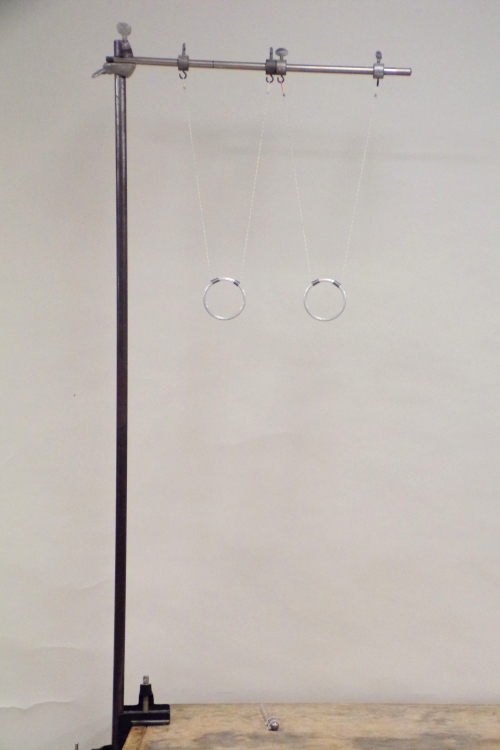

When you alternately push and pull the cow magnet through the (unbroken) metal ring, the ring starts swinging. When you then alternately push and pull the magnet through the ring that has a cut in it, the ring does not move. (When you do this with the unbroken ring, if you time your pushes with the natural frequency of the swing, you maximize the amplitude of the motion.)
This demonstration shows the consequence of Lenz’s law, which states that when a changing magnetic flux induces a current in a loop of wire, the induced current flows in such a direction as to oppose the change that is producing it. (Strictly speaking, the changing magnetic flux induces an electromotive force (emf), which causes a current to flow. It is not uncommon, however, for people to assume that this is understood, and to speak of an induced current.) A current flowing in a loop produces a magnetic dipole field, similar to that of a bar magnet. (See demonstration 68.13 -- Right-hand rule model.) When you bring the cow magnet toward the unbroken metal ring, the current you thereby induce in the ring sets up a magnetic field with the poles on either side of the ring (with the axis perpendicular to the plane of the ring). Lenz’s law dictates that if you approach the ring with the north end of the cow magnet, then the direction of the magnetic field due to the induced current in the ring is such that the north pole faces the north end of the magnet, and the two magnetic fields repel each other. This pushes the ring away from you. Similarly, when you pull the magnet back through the ring, if you have pushed it all the way through, the south pole is now facing the ring, and the magnetic field due to the induced current has the south pole facing the south end of the magnet. These magnetic poles again repel, pushing the ring back toward you.
Conversely, if you pull the north end of the magnet away from the ring, the changing flux now induces a current that sets up a magnetic field with its south pole facing the north end of the magnet. These two poles attract, and you pull the ring toward you. Similarly, if you push the magnet through to the other side of the ring, the induced current produces a field whose north pole faces the south pole of the magnet. These two poles attract, and you push (actually, pull) the ring away from you.
If you try this with the ring that has the cut in it, the ring stays still. There is still an emf induced in the ring, but because of the cut, current cannot flow in a continuous path around the ring, so there is no induced current, and thus no magnetic field.
Faraday’s law, which gives the induced emf as minus the rate of change of magnetic flux, implies the opposition between the change in magnetic flux and the direction of the induced current that is stated in Lenz’s law. (See 72.03 -- EMF induced by moving magnet, 72.48 -- Mutual inductance with coils and galvanometer, and 72.57 -- LR circuit rise time (L/R).) Halliday and Resnick make the interesting observation that if the direction of the induced current were opposite from what it is, if you brought the north pole of a magnet toward the ring, then the magnetic field set up by the induced current would have its south pole facing the magnet, and the ring would be attracted to the magnet. So the ring would accelerate toward the magnet, gaining kinetic energy, and as the current in the ring grew, more and more thermal energy would appear in the ring. This would be a kind of perpetual motion situation, in which the system would gain energy without any actual energy input. Of course, it doesn’t happen this way.
Since the current induced in the ring depends on the rate of change of the magnetic flux, the faster you approach or exit the ring with the cow magnet, the greater the current, the resulting magnetic field and the attraction or repulsion between the magnet and the (unbroken) ring. Thus, the best technique to use when you perform this demonstration is to make quick, darting motions with the magnet, but to time the darting motions with the swinging of the ring to get the greatest amplitude of swing.
References:
1) Halliday, David and Resnick, Robert. Physics, Part Two, Third Edition (New York: John Wiley and Sons, 1977), pp. 772-4.